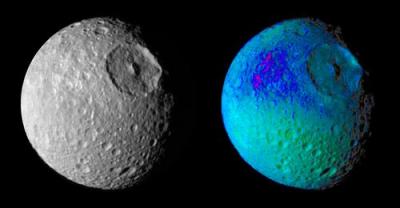Can any other surface in the Solar System be this battered? The twin views below show Saturn’s moon Mimas as imaged by Cassini on August 2. Note how the false-color brings out the variation across this tortured surface — at left is an enhanced clear-filter image, at right a color composite of ultraviolet, infrared and clear-filter images. The most prominent feature in both is the 140-kilometer wide Herschel Crater, an ancient strike that is today filled with landslide material. Close study reveals numerous other craters and long grooves similar to those found on asteroids.
Are these grooves related to the enormous impact that created the Herschel crater? No one knows, but study of this moon’s turbulent history may help scientists understand how many impactors have moved through the Saturn system, a reminder of how dangerous a place the Solar System can be when you’re in the crosshairs of an approaching piece of space debris.
 Mimas is a tiny place, measuring just 397 kilometers across. Its value to us at present is its durability, for it appears that the moon’s surface features date all the way back to its creation. That gives us a superb geological record of what can happen to any celestial object over time. Be sure to look at the Cassini team’s ‘Flying Over Mimas’ animation, taken during a period of seven hours during the recent encounter.
Mimas is a tiny place, measuring just 397 kilometers across. Its value to us at present is its durability, for it appears that the moon’s surface features date all the way back to its creation. That gives us a superb geological record of what can happen to any celestial object over time. Be sure to look at the Cassini team’s ‘Flying Over Mimas’ animation, taken during a period of seven hours during the recent encounter.
Image: False color images of Saturn’s moon, Mimas, reveal variation in either the composition or texture across its surface. During its approach to Mimas on Aug. 2, 2005, the Cassini spacecraft narrow-angle camera obtained multi-spectral views of the moon from a range of 228,000 kilometers (142,500 miles). Credit: NASA/JPL/Space Science Institute.
Centauri Dreams‘ note: The B612 Foundation continues to promote an attempt to significantly alter the orbit of an Earth-crossing asteroid in a controlled manner by 2015. Citing the probability of an ‘unacceptable collision’ in this century of two percent, the group’s project comes into vivid focus when we examine objects like Mimas. The era of massive cratering may be over, but impacts still occur, and a sensible program to identify and tag Earth-crossing objects while developing the technologies to adjust their orbits should be a high priority of the space program.

